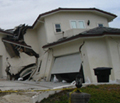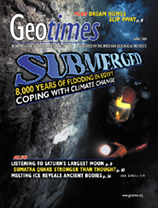
|
Want to write science news? Apply for the Geotimes fall internship! |
||||||||||||||
| |
|||||||||||||||
|
 Dream
homes slip away Dream
homes slip awayListening to Titan Tsunami reveals ancient ruins Sumatra quake stronger than thought Redating the earliest humans Mass extinction, massive problem Space dust and snowball Earth Vesuvius' next eruption New dates defy fixed hotspots Revisiting the Lost City Geophenomena
Print Exclusive
|
||||||||||||||
|
Investing in Cooperative Water Research More funding is essential to the future of U.S. water monitoring and research partnerships. Emery T. Cleaves Political Scene Creationism: Back in Kansas Again In Kansas, some people are trying to redefine science to push forward a religious debate. Linda Rowan Geologic Column Shakespeare or the Monkey? Scientists need to join in the battle to defend the teaching of evolution in the classroom. Fred Schwab |
G. Brent Dalrymple: Deep time in a tarpaper shack Geomedia
|
||||||||||||||
 ON
THE COVER ON
THE COVER A diver examines the wall of a Byzantine structure, measuring 30 by 30 meters (almost 100 by 100 feet), beneath the waves east of Canopus in Abu Qir Bay, Egypt. This settlement became submerged probably in the 7th century, due to a climate change event that caused high floods on the Nile River. Over the last 8,000 years, changes in the Nile have shaped civilization in Egypt. Read story on page 22. Photo courtesy of Jean-Daniel Stanley, Smithsonian Institution and the European Institute of Submarine Archaeology, Paris. |
May: Human Health
|
| SUBSCRIBE | CLASSIFIEDS | ADVERTISE | FOR AUTHORS | CONTACT US | ARCHIVE | SEARCH |
 |
Geotimes Home | AGI Home | Information Services | Geoscience Education | Public Policy | Programs | Publications | Careers |